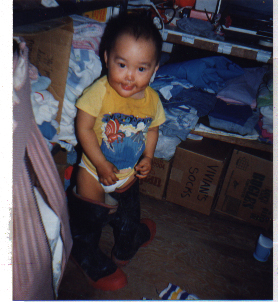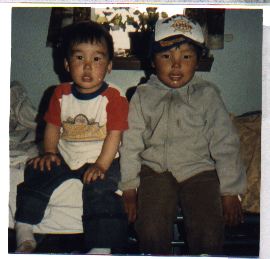|
|
|
 Marshall
Cultural Atlas Marshall
Cultural Atlas
This collection of student work is from
Frank Keim's classes. He has wanted to share these works for others
to use as an example of Culturally-based curriculum and documentation. These
documents have been OCR-scanned. These are available
for educational use only.
INTELLECTUAL DEVELOPMENT
|
13 to 15 MONTHS
|
General
Begins to form concepts.
Notices actions of other children and adults and loves to
mimic all actions.
Explores different features of objects as if studying
them.
Looks in correct place for toys that roll out of sight.
Experiments and invents actions never tried before.
Discovers ability to make things happen by own actions.
Has very short memory and almost no forethought.
Likes to look at picture books and pats recognized
pictures.
Shows interest in new textures by rubbing fingers over
surfaces.
Is able to fit round walk into round hole in form board.
Language
Slowly increases vocabulary from three to four words to
four to six words.
May use sounds to indicate specific objects.
Babbles and jargons with expression.
Amuses self with vocal play.
May attempt to imitate words others say.
May repeat sounds without understanding the meaning of
sounds.
Responds to own name, comes when called.
Understands directions such as "no," "come," "show me."
Recognizes names of major body parts.
Points to familiar toys or persons on request.
|

|
16 to 18 MONTHS
|
General
Gradually refines concepts.
Is very inquisitive about everything.
Remembers where objects belong.
Begins to " figure things out " through thought process.
Has short attention span.
Tries imitate the ways parents use objects.
Enjoys working with shapes on form board.
Scribbles more freely but also can imitate strokes in
drawing.
Identifies simple pictures in book, such as "ball,"
"doggie," etc.
Language
Has vocabulary of six to ten words.
Uses words instead of gestures to express some wants, such
as "up" or "cookie."
Imitate simple sounds on request.
Says "no" more often than any other word.
Obeys command, "Give it to me."
Responds to increasing number of verbal directions if
combined with actions.
Responds delightedly to children's TV shows.
Understands more words than is capable of saying.
Identifies objects by pointing when requested.
Refers to self by name when asked.
Can point to own body parts on request.
May use two-word phrases.
|
|
19 to 21 MONTHS
|
General
Progresses from simple imitation to imaginative
play.
Can remember familiar objects without needing to see
them.
Can obtain familiar objects from different room when
asked.
Places circles, triangles, and squares in form board.
Is interested in tiny things such as bugs.
Looks at books for longer periods of time studying
pictures.
Associates tool with function it performs, such as hammer
for banging.
Completes simple jigsaw puzzle of two to three pieces.
Likes to make marks on paper with big crayon.
Imitate simple actions on request.
Learns to distinguish different sounds and smells.
Language
Has vocabulary of 10 to 20 words.
Enjoys labeling objects and parts of body.
Response to speech with speech.
Uses speech to get desired results.
Combines two different words.
Constantly asks, "What's that?"
Enjoys hearing nursery rhymes.
Likes to respond to directions.
Understands some personal pronouns such as "me."
|
|
22 to 24 MONTHS
|
General
Becomes interested in the outcome of activities rather
than just the activities themselves.
Becomes interested in the precise placement of objects;
enjoys form boards and simple puzzles.
Is curious about objects in environment; feels, squeezes,
pulls and pushes objects.
Follow simple directions.
Is able to match familiar objects.
Identifies familiar objects on TV screen.
May distinguish between "one" and "many."
Maybe it will to recall what is lost and where it might
be.
Recognizes when picture in book is upside down.
Maybe able to draw crude pictures and interpret what they
are.
Distinguishes between vertical and horizontal lines.
Language
Has vocabulary of 50 or more words.
Is able to ask for things using simple words.
Continues to ask, "What's that?"
Is interested in sound repetition.
Understands more words than is able to use.
Substitutes some words for some physical acts.
Asks for food when hungry and water when thirsty.
Answers questions concerning the names of body parts.
Answers simple questions such as, "Where is the doggie?" and
"What does kitty say?"
Understands and asks for "another" and "more."
Listens to an enjoys simple stories.
Imitates parents' words and inflections.
|
|
24 to 30 MONTHS
|
General
Becomes increasingly interested in children's TV
shows.
Understands cause and effect in terms of own behavior.
Is better able to plan a play activity and carry it out.
Is better able to use nearby objects and make-believe
games.
Enjoys playing house and imitating family situations.
Likes to listen to tapes and records of stories and songs.
Remembers sequence of stories and maybe able to retell
stories.
Is able to interpret pictures drawn or painted.
Likes to imitate drawings of older children.
Recognizes familiar signs in environment.
Solves problems by imitating past actions.
Distinguishes between "before" and "after."
Can follow two-step commands.
Language
Has vocabulary of more than 200 words.
Uses two-word sentences.
Refers to self by name; then learns to use pronouns.
Enjoys learning names for new objects.
Uses words to make requests.
Understands a few propositions such as out, in, on.
|

|
30 to 36 MONTHS
|
General
Begins to classify objects into general categories.
Uses symbolic representation in make-believe play.
Tries out various roles in make-believe play.
Tries new play activities to discover more about how things
work.
Becomes more skilled in putting puzzles together.
Reveals intellectual curiosity in reading books and watching
TV.
Can remember and follow three-step commands.
Language
Has vocabulary of more than 500 words.
Creates two to three word sentences, including verbs.
Starts to use past tense and plurals.
Asks names of objects and repeats them.
May use propositions.
Connects names and uses of objects.
Understands relative size (big and small).
|
What Worked
For My Parents in Raising
Their Kids
What
My Parents
Would Have Done Differently
If They Could Do It Over
Again
Advice
From Parents
To Young Parents
Useful
information
for parents
The
Kids
Student
Do's and Do Not's about Parenting
Gems
of Wisdom from
the Elders
Christmastime Tales
Stories real and imaginary about Christmas, Slavik, and the New Year
Winter, 1996 |
Christmastime Tales II
Stories about Christmas, Slavik, and the New Year
Winter, 1998 |
Christmastime Tales III
Stories about Christmas, Slavik, and the New Year
Winter, 2000 |
| Summer Time Tails 1992 |
Summertime Tails II 1993 |
Summertime Tails III |
| Summertime Tails IV Fall, 1995 |
Summertime Tails V Fall, 1996 |
Summertime Tails VI Fall, 1997 |
| Summertime Tails VII Fall, 1999 |
Signs of the Times November 1996 |
Creative Stories From Creative Imaginations |
| Mustang Mind Manglers - Stories of the Far Out,
the Frightening and the Fantastic 1993 |
Yupik Gourmet - A Book of
Recipes |
|
| M&M Monthly |
|
|
| Happy Moose Hunting! September Edition 1997 |
Happy Easter! March/April 1998 |
Merry Christmas December Edition 1997 |
| Happy Valentine’s
Day! February Edition
1998 |
Happy Easter! March/April Edition 2000 |
Happy Thanksgiving Nov. Edition, 1997 |
| Happy Halloween October 1997 Edition |
Edible and Useful Plants of Scammon
Bay |
Edible Plants of Hooper Bay 1981 |
| The Flowers of Scammon Bay Alaska |
Poems of Hooper Bay |
Scammon Bay (Upward Bound Students) |
| Family Trees and the Buzzy Lord |
It takes a Village - A guide for parents May 1997 |
People in Our Community |
| Buildings and Personalities of
Marshall |
Marshall Village PROFILE |
Qigeckalleq Pellullermeng ‘A
Glimpse of the Past’ |
| Raven’s
Stories Spring 1995 |
Bird Stories from Scammon Bay |
The Sea Around Us |
| Ellamyua - The Great Weather - Stories about the
Weather Spring 1996 |
Moose Fire - Stories and Poems about Moose November,
1998 |
Bears Bees and Bald Eagles Winter 1992-1993 |
| Fish Fire and Water - Stories about fish, global warming
and the future November, 1997 |
Wolf Fire - Stories and Poems about Wolves |
Bear Fire - Stories and Poems about Bears Spring,
1992 |
|
 The
University of Alaska Fairbanks is an Affirmative
Action/Equal Opportunity employer, educational
institution, and provider is a part of the University of Alaska
system. Learn more about UA's notice of nondiscrimination. The
University of Alaska Fairbanks is an Affirmative
Action/Equal Opportunity employer, educational
institution, and provider is a part of the University of Alaska
system. Learn more about UA's notice of nondiscrimination.
Alaska Native Knowledge
Network
University of Alaska Fairbanks
PO Box 756730
Fairbanks AK 99775-6730
Phone (907) 474.1902
Fax (907) 474.1957 |
Questions or comments?
Contact ANKN |
|
Last
modified
August 24, 2006
|
|
|